Molecular systematics of the avian schistosome genus Trichobilharzia (Trematoda: Schistosomatidae) in North America
- PMID: 20049999
- PMCID: PMC2922959
- DOI: 10.1645/GE-1870.1
Molecular systematics of the avian schistosome genus Trichobilharzia (Trematoda: Schistosomatidae) in North America
Abstract
Trichobilharzia is a genus of threadlike schistosomes with a cosmopolitan distribution in birds. Species of Trichobilharzia achieve notoriety as major etiological agents of cercarial dermatitis, or swimmer's itch. There are 40 species described in the literature, for which the majority lacks molecular sequence information. To better understand the phylogenetic relationships, diversity, species boundaries, host use, and geographic distribution of this genus better, we surveyed 378 birds and over 10,000 snails from North America. The phylogenetic analysis was based on nuclear 18S, 28S rDNA, internal transcribed spacer region and mitochondrial cytochrome oxidase I sequence data. Specimens were recovered that could be related to 6 of the 14 described species of Trichobilharzia from North America (Trichobilharzia physellae, Trichobilharzia querquedulae, Trichobilharzia szidati, Trichobilharzia stagnicolae, Trichobilharzia franki, and Trichobilharzia brantae). An additional 5 lineages were found that could not be related directly to previously described species. Trichobilharzia brantae, transmitted by Gyraulus parvus, grouped outside the clade containing the recognized species of Trichobilharzia. A subgroup of the Trichobilharzia clade designated Clade Q was comprised of closely related species whose adults and eggs are similar, yet the European species use lymnaeids whereas the North American species use physids as snail hosts. This molecular phylogeny provides a useful framework (1) to facilitate identification of worms, including those involved in dermatitis outbreaks; (2) to test hypotheses about the evolution, diversification, host-parasite interactions and character evolution of Trichobilharzia; and (3) to guide future taxonomic revision of Trichobilharzia.
Figures

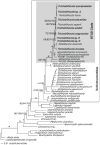
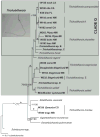
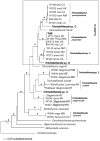
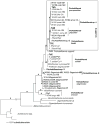
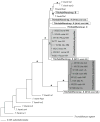
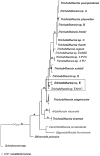

 Physidae,
Physidae,  Lymnaeidae,
Lymnaeidae,  Planorbidae,
Planorbidae,  teal,
teal,  diving ducks,
diving ducks,  Anas americana
Anas americana  most ducks,
most ducks,  swans,
swans,  geese. Eggs scaled to relative sizes.
geese. Eggs scaled to relative sizes.References
-
- Aldhoun JA, Kolářová L, Horák P, Skirnisson K. Bird schistosome diversity in Iceland: molecular evidence. Journal of Helminthology. 2009;83:173–180. - PubMed
-
- Appleton CC. The eggs of some blood-flukes (Trematoda: Schistosomatidae) from South African birds. South African Journal of Zoology. 1982;17:147–150.
-
- Appleton CC. Occurrence of avian Schistosomatidae (Trematoda) in South African birds as determined by faecal survey. South African Journal of Zoology. 1986;21:60–67.
-
- Basch PF. The life cycle of Trichobilharzia brevis, n. sp., an avian schistosome from Malaya. Zeitschrift fur Parasitenkunde. 1966;27:242–251. - PubMed
-
- Baugh SC. Contributions to our knowledge of digenetic trematodes VI. Zeitschrift fur Parasitenkunde. 1963;22:303–315. - PubMed
Publication types
MeSH terms
Substances
Associated data
- Actions
- Actions
- Actions
- Actions
- Actions
- Actions
- Actions
- Actions
- Actions
- Actions
- Actions
- Actions
- Actions
- Actions
- Actions
- Actions
- Actions
- Actions
- Actions
- Actions
- Actions
- Actions
- Actions
- Actions
- Actions
- Actions
- Actions
- Actions
- Actions
- Actions
- Actions
- Actions
- Actions
- Actions
- Actions
- Actions
- Actions
- Actions
- Actions
- Actions
- Actions
- Actions
- Actions
- Actions
- Actions
- Actions
- Actions
- Actions
- Actions
- Actions
- Actions
- Actions
- Actions
- Actions
- Actions
- Actions
- Actions
- Actions
- Actions
- Actions
- Actions
- Actions
- Actions
- Actions
- Actions
- Actions
- Actions
- Actions
- Actions
- Actions
- Actions
- Actions
- Actions
- Actions
- Actions
- Actions
- Actions
- Actions
- Actions
- Actions
- Actions
- Actions
- Actions
- Actions
- Actions
- Actions
- Actions
- Actions
- Actions
- Actions
- Actions
- Actions
- Actions
- Actions
- Actions
- Actions
- Actions
- Actions
- Actions
- Actions
- Actions
- Actions
- Actions
- Actions
- Actions
- Actions
- Actions
- Actions
- Actions
- Actions
- Actions
- Actions
- Actions
- Actions
- Actions
- Actions
- Actions
- Actions
- Actions
- Actions
- Actions
- Actions
- Actions
- Actions
- Actions
- Actions
- Actions
- Actions
- Actions
Grants and funding
LinkOut - more resources
Full Text Sources
Molecular Biology Databases
Research Materials

